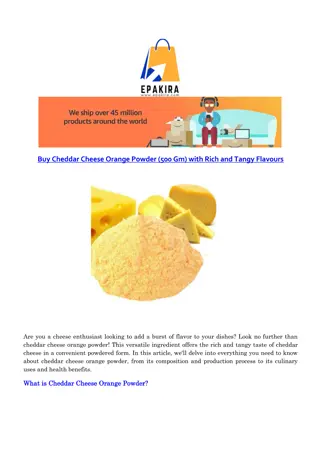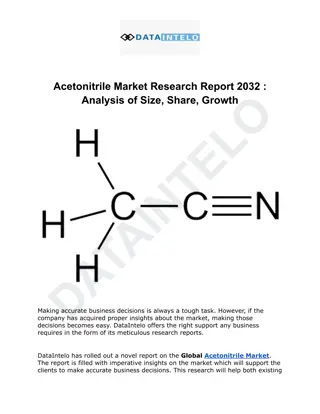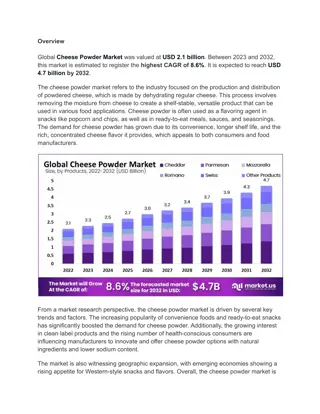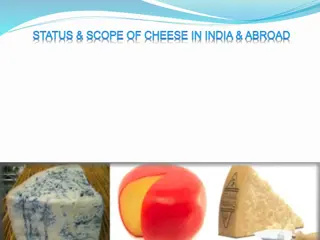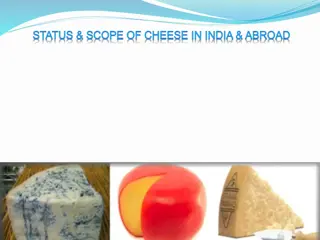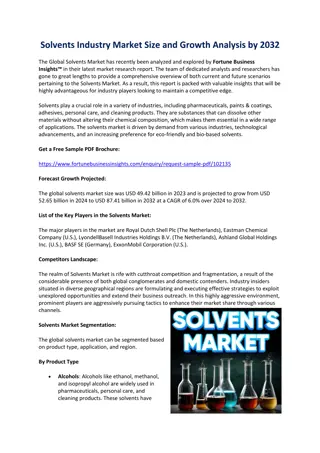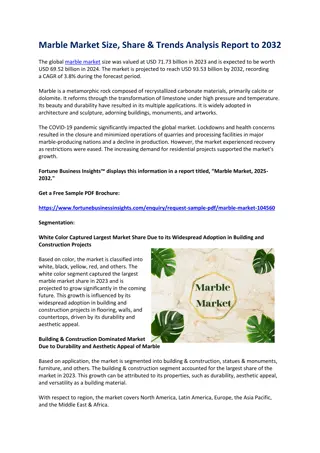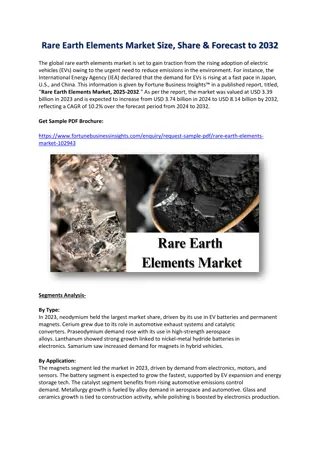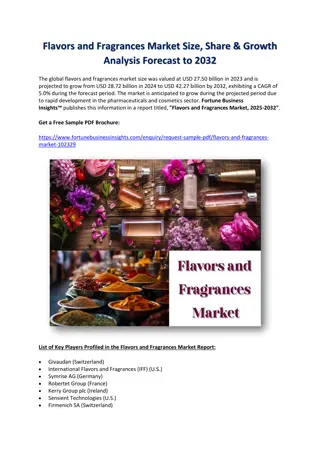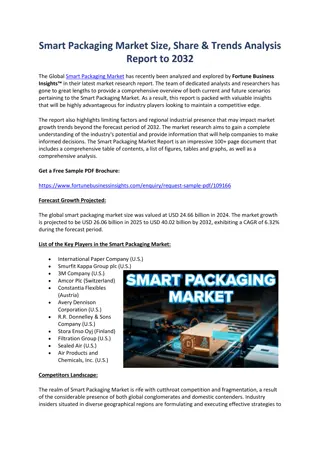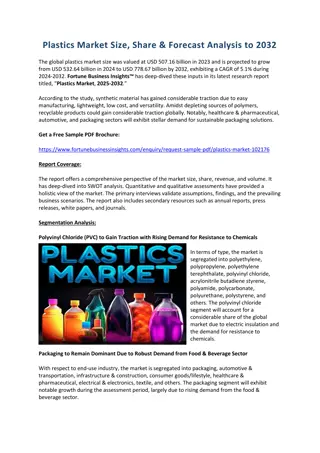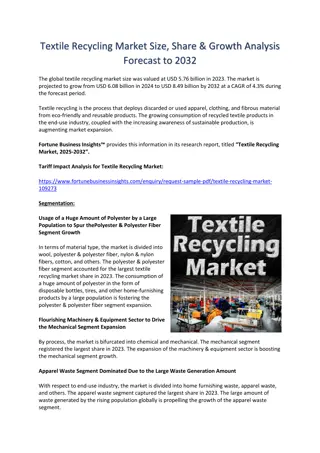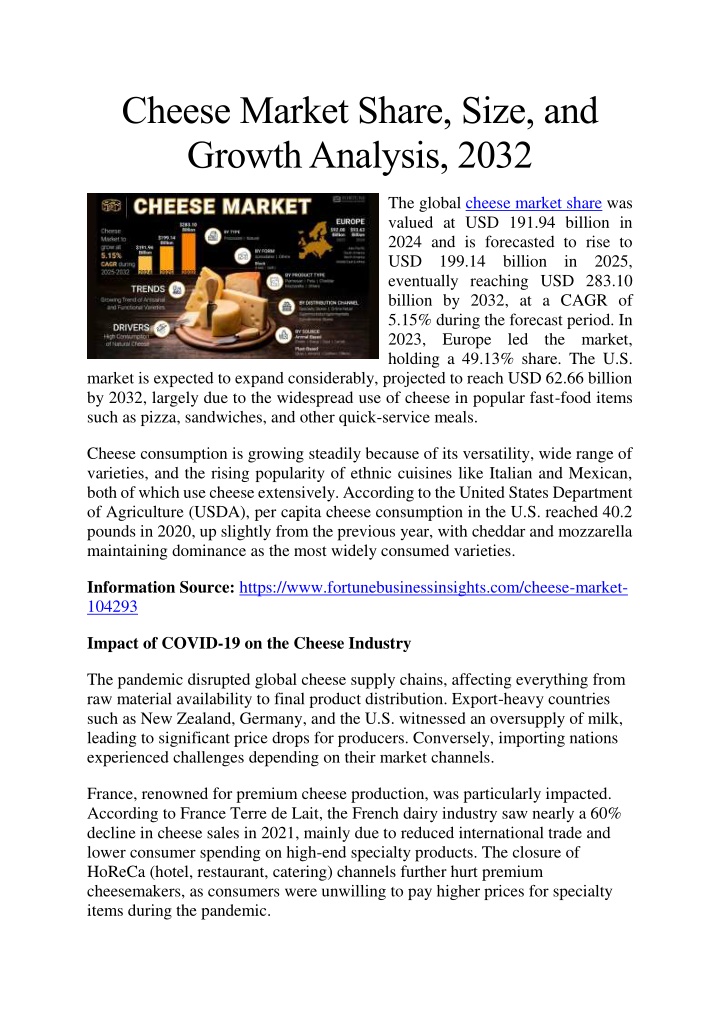
Cheese Market Share, Size, and Growth Analysis, 2032
The global cheese market share was valued at USD 191.94 billion in 2024 and is forecasted to rise to USD 199.14 billion in 2025, eventually reaching USD 283.10 billion by 2032, at a CAGR of 5.15% during the forecast period.
Download Presentation

Please find below an Image/Link to download the presentation.
The content on the website is provided AS IS for your information and personal use only. It may not be sold, licensed, or shared on other websites without obtaining consent from the author. If you encounter any issues during the download, it is possible that the publisher has removed the file from their server.
You are allowed to download the files provided on this website for personal or commercial use, subject to the condition that they are used lawfully. All files are the property of their respective owners.
The content on the website is provided AS IS for your information and personal use only. It may not be sold, licensed, or shared on other websites without obtaining consent from the author.
E N D
Presentation Transcript
Cheese Market Share, Size, and Growth Analysis, 2032 The global cheese market share was valued at USD 191.94 billion in 2024 and is forecasted to rise to USD 199.14 billion in 2025, eventually reaching USD 283.10 billion by 2032, at a CAGR of 5.15% during the forecast period. In 2023, Europe led the market, holding a 49.13% share. The U.S. market is expected to expand considerably, projected to reach USD 62.66 billion by 2032, largely due to the widespread use of cheese in popular fast-food items such as pizza, sandwiches, and other quick-service meals. Cheese consumption is growing steadily because of its versatility, wide range of varieties, and the rising popularity of ethnic cuisines like Italian and Mexican, both of which use cheese extensively. According to the United States Department of Agriculture (USDA), per capita cheese consumption in the U.S. reached 40.2 pounds in 2020, up slightly from the previous year, with cheddar and mozzarella maintaining dominance as the most widely consumed varieties. Information Source: https://www.fortunebusinessinsights.com/cheese-market- 104293 Impact of COVID-19 on the Cheese Industry The pandemic disrupted global cheese supply chains, affecting everything from raw material availability to final product distribution. Export-heavy countries such as New Zealand, Germany, and the U.S. witnessed an oversupply of milk, leading to significant price drops for producers. Conversely, importing nations experienced challenges depending on their market channels. France, renowned for premium cheese production, was particularly impacted. According to France Terre de Lait, the French dairy industry saw nearly a 60% decline in cheese sales in 2021, mainly due to reduced international trade and lower consumer spending on high-end specialty products. The closure of HoReCa (hotel, restaurant, catering) channels further hurt premium cheesemakers, as consumers were unwilling to pay higher prices for specialty items during the pandemic.
Market Segmentation The global cheese market is witnessing strong growth, driven by longer shelf life and increasing consumer preference for natural cheese. The market is segmented by type, source, product, form, and distribution channel. Natural cheese, particularly artisanal varieties enriched with herbs, nuts, and spices, is gaining traction, while processed cheese continues to perform well in emerging markets such as Asia Pacific, South America, and the Middle East & Africa. In terms of source, dairy-based cheese made from cow, goat, sheep, and camel milk dominates the market, but plant-based alternatives from almond, cashew, and soy are rapidly growing in popularity due to the rising trend of veganism. Mozzarella remains the most consumed cheese variety worldwide, supported by its widespread use in popular dishes like pizza. By form, block cheese holds the largest market share owing to its nutritional benefits and suitability for aging, whereas spreadable cheese is seeing increasing demand for its convenience. In distribution, supermarkets and hypermarkets dominate as the leading sales channels, benefiting from their extensive product availability and attractive in- store promotional strategies. Regional Insights Europe leads the global cheese market, driven by strong demand for organic and non-GMO products, while North America is experiencing growth fueled by busy lifestyles and the rising preference for protein-rich, ready-to-eat options, with millennials particularly shaping demand for indulgent, snackable cheese formats. Meanwhile, Asia Pacific and other regions are witnessing accelerating consumption, supported by growing urban household demand and the rapid expansion of the foodservice sector. Market Dynamics The rising adoption of plant-based cheese alternatives is one of the most significant growth drivers, fueled by increasing vegan and flexitarian diets. Innovations in soy-, nut-, and grain-based cheese are creating new growth opportunities. However, concerns over casein a protein in dairy cheese linked to acne, inflammation, and headaches may hinder demand among health- conscious consumers. Competitive Landscape Market leaders are focusing on innovation, product launches, and expanding distribution networks to strengthen their market share.
Key Companies in the Global Cheese Market The Kraft Heinz Company (U.S.) Fonterra Co-operative Group Limited (New Zealand) Arla Foods amba (Germany) FrieslandCampina (Netherlands) Saputo Inc. (Canada) Lactalis Ingredients (France) Wensleydale Creamery (U.K.) Dairy Farmers of America, Inc. (U.S.) SAVENCIA SA (France) Norseland Ltd (Tine Group) (U.K.) Get Sample PDF Brochure: https://www.fortunebusinessinsights.com/enquiry/request-sample- pdf/cheese-market-104293 Recent Development September 2021: Lactalis Canada launched two direct-to-consumer platforms DairyMarketCulinary.ca and Cheeseworld.ca aimed at expanding consumer access to its cheese and dairy offerings through online channels.

